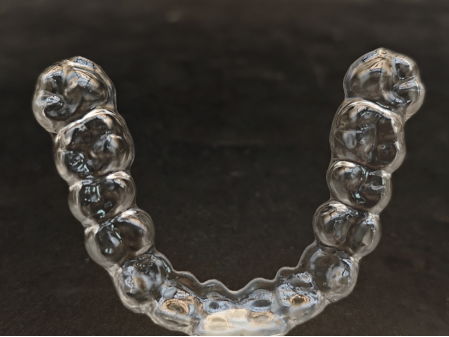Table of Contents
Product Overview
The FabCure N2 is a multifunctional UV post-curing device designed to deliver consistent, high-quality results for 3D-printed parts. Equipped with precisie heating and nitrogen filling, it accommodates the thermal, optical, and oxygen-inhibition characteristics of photopolymer resins. During the post-curing stage, the FabCure N2 enhances both the mechanical strength and surface aesthetics of printed components, ensuring that each restoration or appliance meets the highest professional standards.

Fig 1: FabCure N2
Why We Choose Nitrogen?
When evaluating post-curing technologies, the choice of atmosphere plays a decisive role in the final quality of 3D-printed dental parts. Among all available options, nitrogen stands out as the most reliable and effective solution. Its unique properties directly address the limitations of conventional curing in air, water, or glycerin, ensuring optimal results in both clinical and laboratory applications.
Key Advantages of Nitrogen Post-Curing
●Eliminates Oxygen Inhibition
Prevents oxygen molecules from quenching free radicals, ensuring complete polymerization and tack-free surfaces.
●Superior Surface Finish
Produces smooth, glossy, and stain-resistant surfaces, critical for aesthetic and transparent applications.
●Color Stability
Maintains the original shade of restorations without yellowing, even after extended use.
●Enhanced Mechanical Strength
Creates denser polymer chains, improving hardness, wear resistance, and long-term durability.
●Safe and Cost-Effective
Nitrogen is inert, non-toxic, and widely available, making it a practical choice for clinics and labs.

To further illustrate, we have compared the advantages and limitations of different curing methods across various materials.
| Gas Types | Advantages | Limitations |
| Nitrogen | Highly inert and safe to use Effectively isolates oxygen to prevent surface oxygen inhibition Delivers smooth, glossy surfacescost-effective | Requires N2 gas supply and a sealed environment |
| Fresh Air | Convenient and simple | Oxygen inhibition Surfaces prone to oxidation and roughness Cured models may feel tacky |
| Water Immersion Curing | Reduces oxygen exposure | Surfaces may turn yellow, feel tacky, or show fingerprints Cleaning is difficult Process is complex Poor surface dryness with residue handling challenges |
| Glycerin Curing | Reduces oxygen exposure | Surfaces may turn yellow, feel tacky, or show fingerprints Bubble residues Poor surface dryness |
| Carbon Dioxide | Achieves satisfactory curing results Produces glossy surfaces | Expensive Hazardous to use (Risk of dry ice formation) |
| Vacuum | Reduces oxygen presence | High cost Complex operation Surfaces may still feel tacky with resin residues |

Fig 2: Nitrogen

Fig 3: Water Immersion Curing

Fig 4: Glycerin Curing

Fig 5: Carbon Dioxide
As the comparison shows, while methods such as air, water, glycerin, CO₂, and vacuum curing each have their own applications, they also present significant drawbacks—including incomplete curing, surface tackiness, shade instability, or high operating costs. In contrast, nitrogen curing provides a balanced and superior solution: safe, cost-effective, and capable of delivering fully polymerized, smooth, and color-stable surfaces. This makes nitrogen the most practical and high-performance choice for clinics and laboratories seeking reliable results without compromise.|
The Chemical Mechanism of Nitrogen Curing
Nitrogen curing is based on the principles of free radical polymerization—the fundamental reaction that converts liquid resin into a strong, durable solid under UV exposure.
1.Light Activation – Photoinitiators within the resin absorb UV light energy and generate highly reactive free radicals.
2.Chain Growth – These free radicals initiate chain reactions with monomers, forming long polymer chains that establish the material’s mechanical framework.
If this process is happened in a standard air environment, oxygen molecules bind to and neutralize free radicals, disrupting the polymerization process. This leads to incomplete curing and tacky, discolored surfaces.
If this process is performed in Nitrogen protection environment, by isolating the curing chamber in a nitrogen-rich atmosphere, free radicals remain active and the polymerization process proceeds without interruption.
3.Final Outcome – The result is a fully cured resin characterized by smooth surfaces, stable color, and superior mechanical strength—meeting the highest standards of dental and laboratory applications.
In summary: Nitrogen curing ensures that free radical polymerization proceeds without interruption by effectively isolating oxygen. This results in fully polymerized resin with smooth, glossy surfaces, stable color, and enhanced mechanical strength. By preventing oxygen interference, nitrogen curing guarantees both the aesthetic quality and durability of 3D-printed dental restorations and appliances.
Beyond Nitrogen: Additional Benefits
Besides the benefits provided by nitrogen curing, the FabCure N2 offers several additional features that enhance resin performance and processing reliability:
●Superior Material Performance – Specialized UV exposure ensures printed models become stronger, longer-lasting, and highly resistant to wear and tearing, even in demanding applications. It is safe and reliable, suitable for all types of dental restorations.
●Precise Temperature Control – The chamber rapidly reaches a stable 60 °C from room temperature in just one minute, preventing warping or deformation. This precise thermal management allows each resin to achieve its full mechanical and optical potential.
Application
The FabCure N2 is engineered to meet diverse clinical and laboratory requirements. Through extensive testing and application feedback, it has proven to deliver consistent and reliable outcomes. This makes it the optimal choice across a variety of dental workflows, including:
● Dental Clinic – From crowns, bridges, and All-on-X restorations to retainers and night guards, our solutions deliver the precision, durability, clarity, and comfort essential for lasting clinical success and patient satisfaction.
● Dental Lab – From diagnostic and orthodontic models to implant planning models and surgical guides, our solutions deliver the accuracy, stability, and reliability essential for efficient laboratory workflows.
Fig 6-9 : Dental Applications Cured with FabCure N2
Conclusion
The FabCure N2 integrates advanced UV curing technology with a controlled nitrogen environment, solving the common limitations of conventional post-curing. By ensuring color stability, flawless surface quality, and outstanding mechanical performance, it sets a new benchmark for digital dentistry and high-precision 3D printing.
The FabCure N2 delivers confidence, consistency, and clinical excellence—making nitrogen curing the standard for professionals who refuse to compromise on quality.
 ENG
ENG













